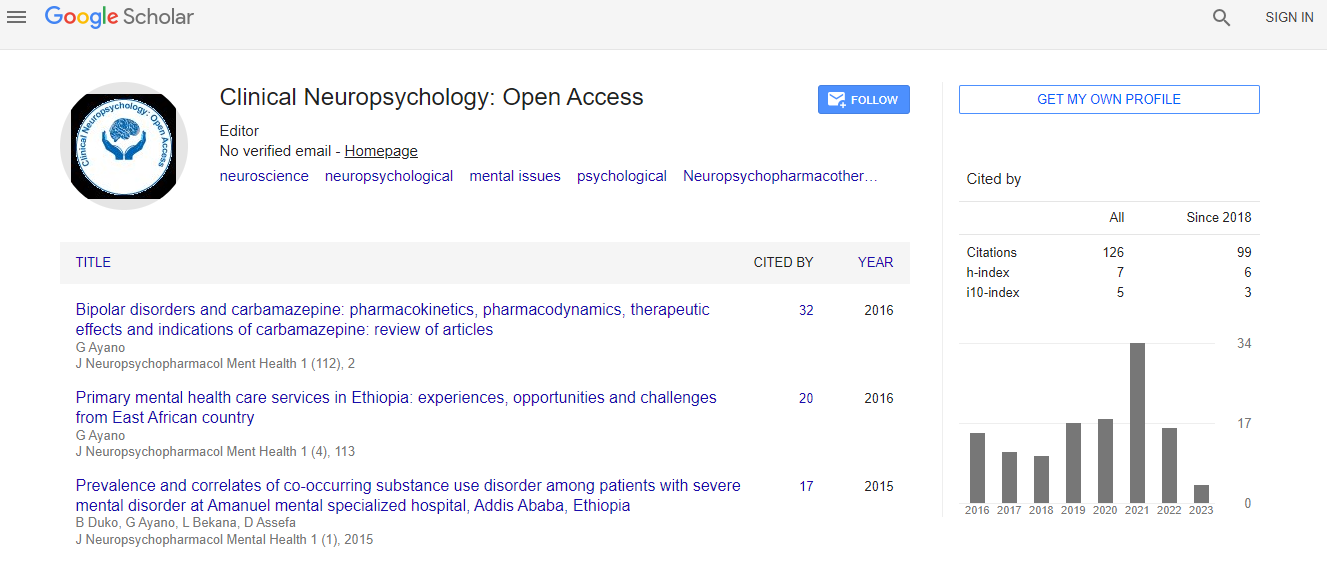Our Group organises 3000+ Global Conferenceseries Events every year across USA, Europe & Asia with support from 1000 more scientific Societies and Publishes 700+ Open Access Journals which contains over 50000 eminent personalities, reputed scientists as editorial board members.
Open Access Journals gaining more Readers and Citations
700 Journals and 15,000,000 Readers Each Journal is getting 25,000+ Readers
Google Scholar citation report
Citations : 141
Clinical Neuropsychology: Open Access received 141 citations as per Google Scholar report
Indexed In
- Google Scholar
- RefSeek
- Hamdard University
- EBSCO A-Z
- OCLC- WorldCat
Useful Links
Recommended Journals
Related Subjects
Share This Page
Neuroprotective, anti-inflammatory and immunomodulatory activities of Ozoroa pulcherrima and Sida pilosa extracts on murine model of neuroschistosomiasis
8th Global Experts Meeting on Advances in Neurology and Neuropsychiatry
Ulrich Femoe Membe, Hermine Boukeng Jatsa, Theophile Dimo and Louis Albert Tchuem Tchuente
University of Yaounde, CameroonCentre for Schistosomiasis and Parasitology Yaounde, Cameroon
Posters & Accepted Abstracts: ClinNeuropsychol
Abstract
Background: Schistosomiasis (bilharziasis) is an infectious parasitic disease caused by blood flukes of the genus Schistosoma. Schistosomiasis is an important public health problem in Africa. After malaria, it is the second most prevalent tropical disease, affecting at least 258 million people worldwide and 90% in Africa (WHO, 2017). The eggs released by the adult female worm are mainly responsible to the pathology where they are deposited in the liver, intestine, uro-genital or Central Nervous System (CNS). The most severe clinical outcome associated with this parasite is the infection of the CNS known as Neuroschistosomiasis (NSM) and can affect the brain or the spinal cord occurring during all phases of schistosomiasis and resulting to severe complications. Chronic neuroschistosomiasis results from the host’s immune response to the eggs and the resultant granulomatous reaction and fibro-obstructive disease. Once deposited into CNS, the mature embryo secretes immunogenic substances that causing inflammatory reaction leading to a periovular granulomatous reaction. In the early phase of schistosomiasis (the first 110 days) the immune response reaches maximum intensity. The granulomas successfully destroy the ova but result in fibrotic deposition in the host tissue. The mass effect of thousands of eggs and the large granulomas concentrated within the brain or spinal cord leads to symptoms such as headache, focal or generalized seizures, ataxia, nystagmus, nausea and vomiting, intracranial hypertension and neurological deficit. Purpose: Many clinical cases have been reported by several authors and many experimental studies have been performed to evaluate the immunopathology and diagnosis during CNS invasion by Schistosoma. Moreover, there is no definitive consensus regarding therapy of NSM. Therefore, the search for alternative or complementary drugs has become a priority. Sida pilosa and Ozoroa pulcherrima are good drug candidate against Schistosoma infection. These plants have been studied in our research team and showed schistosomicidal effects (in vitro and in vivo), antifibrotic and anti-inflammatory activities (in vivo) on mice liver infected by Schistosoma mansoni. Objective: We aimed for our PhD research to evaluate neuroprotective and neuroimmunomodulatory effects of these to plants extracts on mice model of neuroschistosomiasis induced by Schistosoma mansoni. Experimental design: The research design will consist to infect mice with Schistosoma mansoni cercariae (80 cercariae per mouse). Twelve weeks after untreated and treated mice will go through the behavioral and neurocognitive tests (Open Field, Traction test and T maze) and sacrificed. Histological and immunohistochemical analyses performed to evaluate inflammation and necrosis in brain and spinal cord tissue as well as inflammatory and profibrotic biomarkers (INF-γ, TNF-α, IL-10; IL-13, NFκ-b, BDNF and C-reactive protein) in serum and brain tissue.Biography
Ulrich Femoe Membe is currently doing his doctoral degree at University of Yaounde, Cameroon.
E-mail: ulrichfemoe10@gmail.com

 Spanish
Spanish  Chinese
Chinese  Russian
Russian  German
German  French
French  Japanese
Japanese  Portuguese
Portuguese  Hindi
Hindi 